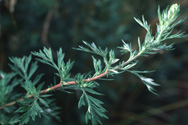
Photo © Steven Foster
Introduction
Mugwort is a perennial shrub that grows to 5 feet with small, reddish-brown or yellow flowers.1 It originated in the temperate regions of the northern hemisphere, and can be found today throughout Europe, Asia, North America, and England.2,3 Primarily, the leaves and the roots of mugwort are harvested.4 History and Cultural Significance
Mugwort has been used in traditional medicine as a food additive, a tonic, a tea, and a bath steep.1-3 The volatile oils have been used in aromatherapy for their pleasantly aromatic smell.1 Mugwort is said to have derived its name from its traditional use as a flavoring agent for beer before the regular use of hops.3 However, many believe that the name is not representative of the beverage but rather moughte which means moth or maggot, since this herb was used traditionally to repel moths. Another name for this herb is St. John’s plant (not to be confused with St. John’s wort) because it was believed that John the Baptist wore a mugwort wreath in the wilderness. Building upon this idea, many beliefs arose suggesting that travelers should wear mugwort to ward off wild beasts and evil spirits as well as to protect them from fatigue, sunstroke, and disease.3 In India, mugwort was traditionally used for the treatment of fever, as well as to stimulate and regulate menstruation.1 Other traditional uses for mugwort included treating diarrhea, constipation, cramps, and worm infestations.5 Tonics made from mugwort root were also thought to be beneficial in the treatment of various complaints including anxiety, irritability, and restlessness.5 Currently, mugwort is occasionally used in Germany for the treatment of intestinal gas, stimulation of digestion, and bloated distension of the stomach.1 Externally, mugwort essential oil has been employed as an insect repellant.1 An ancient but still used Chinese acupuncture technique involves rolling the crushed mugwort leaves into sticks, called moxa, which are ignited and applied either directly or indirectly as a heat source to improve circulation at specific acupuncture points.6 Modern Research
There are currently no clinical studies investigating the internal uses of mugwort. Future Outlook
Artemisia vulgaris is considered a noxious weed in many areas because it is extremely invasive and aggressive and is believed to inhibit the growth of nearby plants.7 Once established, it is difficult to eradicate and is, therefore, a concern in farming areas where it occurs. In Canada, mugwort is being studied for its potential as a commercially grown hydroponic crop.8 References
1 Wichtl M, Brinckmann J. Herbal Drugs and Phytopharmaceuticals. 3rd ed. Stuttgart: Medpharm GmbH Scientific Publishers; 2004. 2 Chevallier A. The Encyclopedia of Medicinal Plants. London: Dorling Kindersley Ltd.; 1996. 3 Grieve M. A Modern Herbal. Vol. 2. New York: Dover Publications Inc.; 1971. 4 Bown D. New Encyclopedia of Herbs and Their Uses. New York: DK Publishing Inc. 2001. 5 Blumenthal M, Busse WR, Goldberg A, Gruenwald J, Hall T, Riggins CW, Rister RS, eds. Klein S, Rister RS, trans. The Complete German Commission E MonographsūTherapeutic Guide to Herbal Medicines. Austin, TX: American Botanical Council; Boston: Integrative Medicine Communication; 1998. 6 Cardini F, Weixin H. Moxibustion for correction of breech presentation: a randomized controlled trial. JAMA. 1998;280(18):1580-1584. 7 Wormwood, Mugworts. Available at: http://www.ienica.net/crops/artemisia.htm. Accessed April 14, 2005. 8 Dorais M, Papadopoulos AP, Luo X, Leonhart S, Gosselin A, Pedneault K, et al. Soilless production of greenhouse plants in north eastern Canada. ISHS Acta Horticulturae 554: World Congress on Soilless Culture: Agriculture in the Coming Millennium. Available at: http://www.actahort.org/books/554/554_32.htm. Accessed April 14, 2005.
|